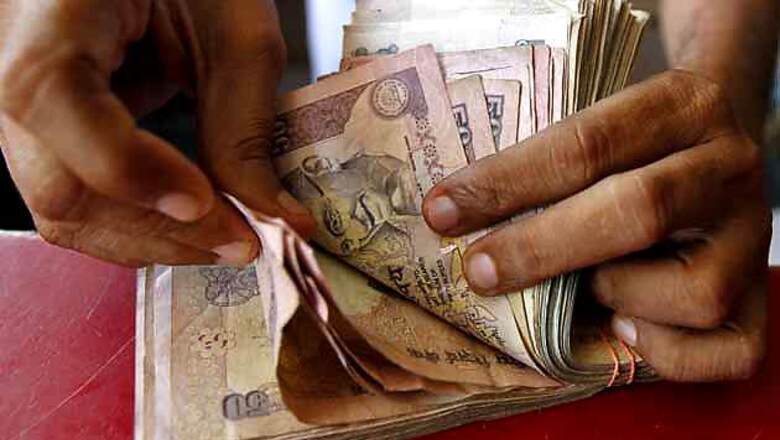
views
Mumbai: The rupee fell to a record low of 58 against the dollar on Monday, escalating worries about the current account deficit and complicating the task for policy makers looking to revive an economy that grew at its slowest in a decade in 2012/13.
The Finance Ministry's chief economic adviser Raghuram Rajan said India would continue to take measures to curb the current account deficit, calling the rupee fall a temporary phenomenon - in line with recent comments from Indian government leaders blaming global factors.
While analysts agree that the rupee has run into a broader dollar rally that is also pressuring other emerging currencies such as the Indonesian rupiah, India's currency is seen as more vulnerable due to the country's high fiscal and trade deficits.
A weaker currency could undermine recent fiscal and economic measures by the government that helped spark a surge in foreign inflows. It also complicates the RBI's campaign to cut interest rates in a country still facing the prospect of losing its investment-grade ratings.
"A weak rupee can revive a number of past woes, upset the easing inflation trajectory, raise CAD financing concerns and up the currency risks for offshore borrowers. This might also raise another hurdle for the central bank for cutting rates," said Radhika Rao, an economist with DBS Bank in Singapore.
The Reserve Bank of India is due to make its next monetary policy statement on June 17, and many economists and traders expect it to pause in its monetary easing after cutting rates by 25 basis points in each of its past three reviews.
The rupee fell to a record low of 57.81 on Monday as the dollar gained on data showing China's economy losing momentum and after a reasonably healthy pace of US job creation renewed expectations the Federal Reserve might curb its asset purchases later this year.
The tumble comes as the Indian economy appears to have better momentum than it did exactly a year ago when the rupee last hit a record low, but still faces a long road to recovery.
The most immediate risk centres around financing the current account deficit. That measure had been expected to have narrowed this year from a record 6.7 percent of gross domestic product in the October-December quarter due to falling prices for gold and oil - the country's two biggest imports.
Worries over the current account have been exacerbated by foreign investor net sales of more than $2.5 billion in domestic debt over the previous 12 sessions, spurred by concerns that the weaker rupee would erode returns.
Finance ministry officials told Reuters the falling rupee was discussed in a previously scheduled meeting on Monday with market regulators and the central bank.
"The FII (foreign institutional investors) capital outflows are likely to continue for next 10-15 days," he said adding rupee could touch even 58 or 59 against the dollar if the outflows continued.
Overseas funds are vital to India's economy as a surge in net foreign buying since 2012 - totalling almost $50 billion in both debt and stocks - has been key in narrowing the deficit.
"The current account deficit is large, which needs large amount of capital inflows. The dependence on short-term debt is resulting in the hammering of the rupee," said Sujan Hajra, chief economist at Anand Rathi Securities.
Policy makers
Additional interest rate cuts are critical to boosting growth and reviving confidence in the economy, and have a bigger bearing on the rupee than yields alone. Although wholesale inflation fell below 5 percent in April, retail inflation remains high.
"Keeping rates high - on the ground of defending INR, at least - will likely only further defer recovery, deter FII equity inflows, delay re-accumulation of FX reserves and depreciate the INR," Bank of America-Merrill Lynch said in a note on Sunday.
Meanwhile, the government faces a gridlocked parliament ahead of national elections due by next year, limiting its scope for additional fiscal or economic reforms.
That leaves it in a weaker position than last year, when, chastened by the downgrade of its sovereign rating outlook by Standard & Poor's and Fitch Ratings, India passed a slew of measures including opening up the retail sector and raising debt investment limits for foreign investors.
The RBI and government efforts not only helped attract foreign investments, they've also helped feed expectations for a mild recovery in economic growth which slowed to a decade low of 5 percent in the fiscal year ended in March.
The outlook for the rupee is also being constrained by the perception policy makers will only use small measures to defend the rupee, given that they blame global factors, which may work in the near term but may not be enough should there be sustained gains in the dollar.
Finance ministry officials told Reuters the government was considering easing investment rules for sovereign wealth funds , and added the government would take steps to calm markets, although they noted they had limited room to move for now.
"In the short-term, we can do little," said the official.
RBI Governor Duvvuri Subbarao said last week any defence of the rupee has to be credible, in comments that have put into question whether the central bank will even intervene.
"The panic this time round at least in sentiment appears more controlled," DBS's Rao said. "Yet in countries like India and Indonesia, where current account position is in a precarious situation, the impact might be more profound."




















Comments
0 comment